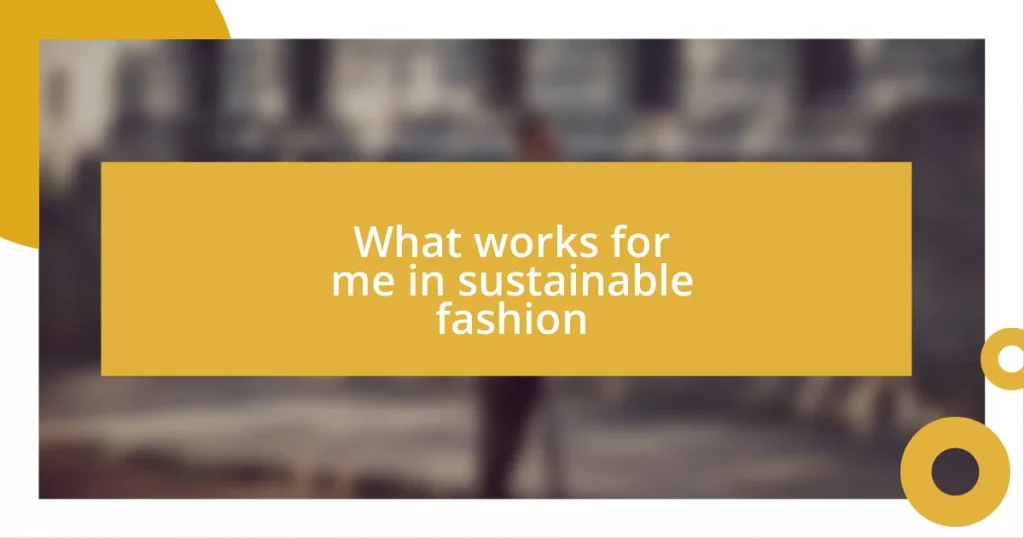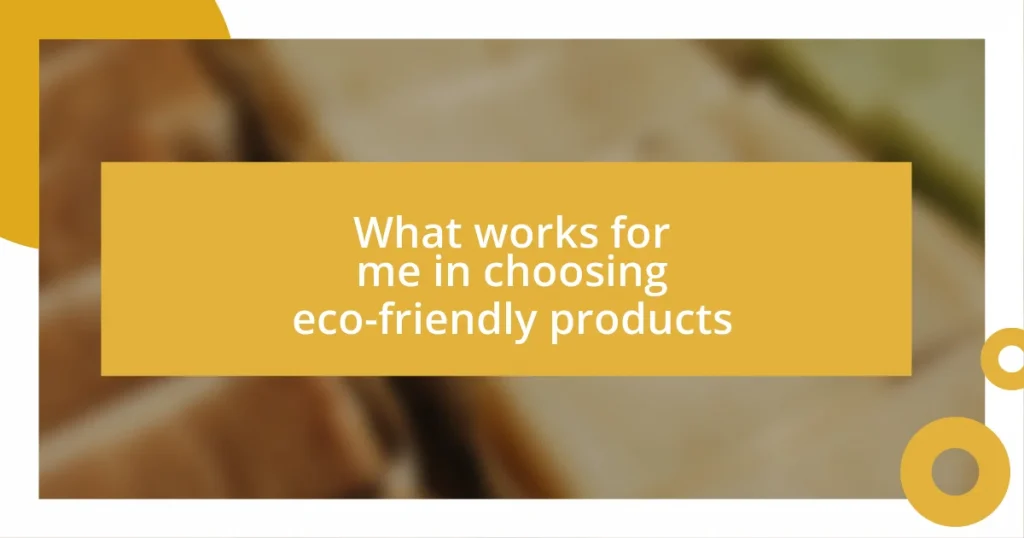Key takeaways:
- Understanding the impact of fashion consumption is essential; opting for second-hand and sustainable materials can significantly reduce one’s carbon footprint.
- Building a sustainable wardrobe involves decluttering, prioritizing versatile pieces, and supporting local, ethical brands for a more meaningful fashion experience.
- Maintaining and upcycling clothing not only promotes creativity and sustainability but also fosters a sense of community through sharing and swapping with others.

Understanding sustainable fashion choices
Sustainable fashion choices often begin with understanding the impact of our purchases. I still remember the first time I learned about fast fashion’s detrimental effects—seeing a documentary that opened my eyes to the pollution and waste was shocking. It made me question: how can I continue contributing to something so harmful while still enjoying fashion?
When I started exploring alternatives, I discovered the power of second-hand shopping. A trip to my local thrift store felt like treasure hunting, uncovering unique pieces that told their own stories. It hit me then that these choices not only reduced my carbon footprint, but also gave garments a new life, transforming my wardrobe into a more personal and meaningful collection.
It’s also crucial to consider the materials we choose. The first time I touched organic cotton, I was struck by how soft and breathable it was compared to conventional fabrics. That moment taught me that quality often outweighs quantity—opting for a few well-made items instead of a closet full of poor quality pieces became my new mantra. Each choice felt like a small rebellion against the norm, and I found joy in being part of a movement that prioritizes our planet and its people.

Benefits of sustainable fashion
The benefits of sustainable fashion extend far beyond personal style; they touch on environmental, economic, and social dimensions. I remember the sense of relief that washed over me when I realized my wardrobe could reflect my values, not just trends. By choosing sustainable brands, I felt a deeper connection to the pieces I wore, knowing they were crafted with care rather than mass-produced in harmful conditions.
Here are some key benefits of sustainable fashion:
- Environmental Impact: Reduced pollution and waste, making a positive contribution to our planet’s health.
- Quality Over Quantity: Sustainable pieces often last longer, saving money in the long run because you buy less.
- Supporting Local: Many sustainable brands prioritize local artisans, which helps boost local economies and preserve traditional craftsmanship.
- Ethical Production: By choosing ethically made clothing, I support fair wages and safe working conditions for workers.
- Unique Fashion Choices: Sustainable fashion often means unique designs that stand out, allowing personal expression without conforming to cookie-cutter trends.
These insights are not just statistics for me; they reflect a lifestyle shift that brings both satisfaction and purpose.

Building a sustainable wardrobe
Building a sustainable wardrobe is a journey of intentional choices. I can still recall that moment in my closet when I decided to sift through my belongings and donate those pieces I hadn’t worn in ages. It felt liberating to declutter, but it was even more satisfying knowing that someone else might find joy in what I no longer valued. That experience truly exemplified how fashion can circulate, creating a more sustainable ecosystem.
When curating my sustainable wardrobe, I now prioritize versatility. One evening, I wore a chic dress that I paired with sneakers for casual outings and then dressed up with heels for a night out. I realized that having a few versatile pieces allowed for endless combinations, reducing the need for excess. This not only streamlined my closet but also minimized impulse buys, making every purchase more meaningful.
Building a wardrobe centered around sustainability also means being mindful of the brands I support. I often share stories with friends about the local designers I’ve discovered—each piece feels like a conversation starter, with a background story that resonates. When I wear something handmade by a local artisan, it carries an energy that mass-produced items just can’t match. This emotional connection reminds me that my choices echo my values, making fashion a beautiful extension of who I am.
| Aspect | Details |
|---|---|
| Decluttering | Donating unneeded clothing promotes reuse and gives new life to fashion items. |
| Versatility | Choosing items that can be styled in various ways reduces the need for multiple purchases. |
| Brand Support | Supporting local and ethical brands fosters community and sustainability. |

Choosing eco-friendly materials
Choosing eco-friendly materials is a pivotal step in the sustainable fashion journey. I vividly remember the first time I held a piece made from organic cotton. It felt so different from conventional fabrics—softer, almost like it breathed with a purpose. This experience opened my eyes to the importance of material sourcing; it’s not just about what I wear, but what’s happening behind the scenes. Why wouldn’t I want to support materials that are kinder to both the planet and my skin?
I often find myself gravitating toward fabrics like Tencel and hemp, which are not only sustainable but also stylish in their own right. Tencel, derived from sustainably sourced wood, feels luxurious to touch and has a stunning drape. When I wear it, I feel this unique blend of comfort and environmental responsibility. Have you ever put on a garment and felt a flicker of pride? Choosing materials like these makes me feel like I’m part of a movement towards better fashion choices.
Additionally, I pay close attention to how brands communicate their material choices. I appreciate when companies transparently share their sourcing stories. For instance, when I learned about a brand that uses recycled plastics to create stunning activewear, I found it inspiring. It made me reflect on how every piece I choose could contribute to reducing waste and promoting a circular economy. Isn’t it empowering to know that my wardrobe could help reshape the fashion narrative? Embracing eco-friendly materials not only enhances my personal style but also allows me to make a positive impact.

Supporting ethical brands
Supporting ethical brands feels like a conscious pledge to a more thoughtful fashion future. I still remember the first time I stumbled upon a local brand that not only crafted beautiful garments but also valued fair labor practices. There’s something incredibly rewarding about knowing that my purchase directly supports artisans and workers who are treated fairly. It’s like I’m part of their journey, a shared vision of sustainable fashion.
I recall the joy of attending a pop-up shop hosted by a small designer who sourced materials ethically and produced everything in-house. As I chatted with her, I learned about the struggles and triumphs behind each piece. Instead of just buying clothes, I was investing in a story, a mission that aligned with my values. This connection creates a sense of community, making each garment feel like a cherished artifact rather than just another item in my closet.
When I experience the energy of an ethical brand, I often think about the ripple effect my choices create. Supporting these brands means I’m contributing to a bigger movement that fights fast fashion’s detrimental impact. It’s empowering to know that by choosing to shop ethically, I’m voting for a fashion industry that prioritizes people and the planet. Isn’t it amazing how each purchase can be a step towards change?

Incorporating second-hand shopping
Incorporating second-hand shopping into my wardrobe has transformed my approach to fashion. I still remember the thrill of my first thrift store excursion, sifting through racks of unique finds. It felt like a treasure hunt, and I discovered a vintage leather jacket that instantly became my go-to piece. Can you recall the last time you found something truly special while shopping second-hand? That rush of excitement makes me appreciate each item so much more.
Every time I choose second-hand clothes, I’m not just curbing my spending—I’m actively reducing waste. Knowing that I’m giving a second life to garments that might have otherwise gone to landfills fills me with a sense of purpose. Recently, I came across a pair of jeans that fit like a dream. Finding that perfect fit in a pre-loved pair felt like striking gold, and I love that I was able to save them from becoming part of the fashion cycle’s waste. Can you think of a time when sustainability felt as rewarding as a fashion win?
Moreover, exploring thrift shops or online second-hand marketplaces connects me with the stories behind every piece. I recently discovered a cozy knit sweater that carried the faint scent of lavender, as if it had been lovingly worn by someone who cherished it. Each thread seems to weave a narrative, inviting me to add my chapter to its history. Isn’t it fascinating to think that by choosing second-hand, we’re joining this ongoing tapestry of style and sustainability?

Maintaining and upcycling clothing
Maintaining and upcycling clothing is an incredible journey that sparks both creativity and sustainability. I remember the excitement I felt when I first learned how to sew simple repairs on my favorite shirt. That little hole in the fabric became a moment of self-expression, as I stitched in a contrasting thread to add character. How satisfying is it to know that instead of tossing it out, I turned a small flaw into a design feature?
Thinking about upcycling, I recently transformed an old pair of jeans into a trendy tote bag. It was both a fun project and an opportunity to give these jeans a new purpose rather than letting them languish in the back of my closet. With every snip and stitch, I felt a growing appreciation for the resources and effort that went into creating those jeans in the first place. Have you ever thought about the hidden potential of your worn-out clothing?
I’ve also embraced a habit of refreshing my wardrobe by swapping clothes with friends. The last swap I hosted was such a delightful experience! As we exchanged pieces we no longer wore, laughter and stories filled the room, and we each walked away feeling like we’ve added something fresh to our closets—without spending a dime! Isn’t it remarkable how a simple clothing swap can breathe new life into pieces we once considered outdated?













